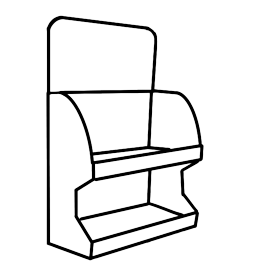Example 8 again demonstrates and summarizes the relative size of intervals. In the second measure, GE form a major sixth, which becomes a minor sixth when the top note is lowered by a half step. It only takes a minute to sign up. Consonant intervals are intervals that are considered more stable, as if they do not need to resolve, while dissonant intervals are considered less stable, as if they do need to resolve. And the fifth doesn't add harmonic content because it is the strongest overtone in the harmonic series. ehhhI guess that's An ordered collection of half steps (H) and whole steps (W) as follows (ascending): WWHWWWH. For example, the song Amazing Grace begins with a perfect fourth. So, if you were given this interval to identify, you might consider inverting the interval. This is called octave equivalence, the assumption that pitches one or more octaves apart are musically equivalent in many ways, leading to the convention "that scales are uniquely defined by specifying the intervals within an octave". The second group includes the perfect fifth or perfect fourth. In the first group, all intervals of a unison or an octave are called perfect because the note is not changed. The octave requires that: The interval must be an octave interval (8 note names between the first and the last). okmaybe? The modern Western music system has been inherited from some of the groundwork set by Pythagoras. Perfect Octave Interval - Ear Training Preview E Sonid Preview E 1 Gravity John Mayer 4:05 2 Can't Buy Me Love - Remastered 2009 The Beatles 2:11 3 Don't Speak No Doubt 4:23 4 Don't Worry 'Bout Me Frank Sinatra 3:06 5 Norwegian Wood (This Bird Has Flown) - Remastered 2009 The Beatles 2:04 6 Singin' in the rain Gene Kelly, Nacio Herb Brown 2:53 7 While octaves commonly refer to the perfect octave (P8), the interval of an octave in music theory encompasses chromatic alterations within the pitch class, meaning that G to G (13 semitones higher) is an Augmented octave (A8), and G to G (11 semitones higher) is a diminished octave (d8). From a JI perspective, the major second really splits into two notes, namely 9/8 (which is to be found at about 2.04 semitones above the tonic) and 10/9 (which is to be found at about 1.82 semitones above the tonic). Example 3. I think the best approach is the practice itself, which of course is music and musical instruments and listening. The best answers are voted up and rise to the top, Start here for a quick overview of the site, Detailed answers to any questions you might have, Discuss the workings and policies of this site. The perfect fifth and the perfect octave are considered perfect consonances. The top note is then raised by a half step to E, making the interval into an augmented sixth (A6 or +6). To Pythagoras, and possibly many Greeks at the time, certain intervals sounded very pleasing to the ear. All the rest have answered in terms of high-level music theory concepts, but I think it can be interesting to look at the intervals as raw coefficients instead. The notation 8a or 8va is sometimes seen in sheet music, meaning "play this an octave higher than written" (all' ottava: "at the octave" or all' 8va). Imagine that the bottom note of the interval is the tonic of a major scale. Sometimes 8va is used to tell the musician to play a passage an octave lower (when placed under rather than over the staff), though the similar notation 8vb (ottava bassa or ottava sotto) is also used. Quantity tells us roughly how far apart the notes are on the scale; and quality tells us more about the unique sound of the interval or which scale it's pulling from. nope nope nope nope nope, The DEFINITELY didn't workLet's try something else. The final chord note names and note interval links are shown in the table below. Intervals are categorized as consonant or dissonant. @Anthony It can. The left column shows that seconds, thirds, sixths, and sevenths are major and/or minor, while the right column shows that unisons, fourths, fifths, and octaves are perfect intervals. Perfect intervals are also defined as those natural intervals whose inversionsare also perfect, where natural, as opposed to altered, designates those intervals between a base note and another note in the major diatonic scale starting at that base note (for example, the intervals from C to C, D, E, F, G, A, B, C, with no sharps or flats); this Perfect intervals aren't simply there because they are the most consonant or stable or whatever. It can greatly ease your ability to bring out more complex emotional tapestries in your harmonies. If we take a middle C (C4) with frequency of 261.63 Hz If we take one octave higher that'd be 2*261.63 Hz (C5) = 523.26 Hz. The tritone is just an oddball from this (over-)simplified view. The Perfect intervals are the Perfect 4th, 5th, Octave, and Unison. The interval must have 12 half steps. In other words, when the two frequencies resonate together and the ratio of the frequencies comes out in either of these forms many people in Western culture would agree they are pleasing. There is also the fact that in the modern era we have become increasingly attracted to dissonant or unusual forms of harmony. Interval between one musical pitch and another with double its frequency, Audio playback is not supported in your browser. Consequently: These are the most common compound intervals that you will encounter in your music studies. It will be important to keep in mind at all times that intervals are both written and aural, so that you are thinking of them musically (and not simply as an abstract concept that you are writing and reading). Each row in this chart is enharmonically equivalent. In music theory, the octave is an interval that has twelve half steps. Whether an interval is "perfect" or "major" depends on mathematical ratios of frequencies as determined by the Greeks. Other cultures (Persian music) have divided the octave into 53-tones, 24-tones (some forms of Indian music), and other divisions. Octave interval. The point I was trying to make was that the Pythagoreans recognized superparticular ratios as being consonant but did not extend this principle beyond the fourth harmonic. I would be interested in anything you guys find as well. Always begin with one when counting size. There is a 'rule of nine'.Minors become majors, majors become minors, augmenteds become diminisheds, etc. I like @Dan04's answer re. Seconds invert to sevenths (2 + 7 = 9) and sevenths invert to seconds. In Example 7b, the perfect fifth FC becomes diminished when the bottom note moves up a half step to F. https://en.wikipedia.org/wiki/Interval_(music), music.stackexchange.com/questions/63589/, New blog post from our CEO Prashanth: Community is the future of AI, Improving the copy in the close modal and post notices - 2023 edition. @Kaji Not exactly. It hasn't changed. M2, M3, M6, etc.) This is simply a fourth that is neither augmented nor diminished. Quality more precisely measures written distance between notes, andin combination with an intervals sizeit describes the aural sound of an interval. First, this interval is a generic sixth (E to itself is 1; to F is 2; to G is 3; to A is 4; to B is 5; to C is 6). To identify an interval (size and quality) using this method, complete the following steps: Example 5 shows two intervals. These intervals are called "perfect" most likely due to the way that these types of intervals sound and that their frequency ratios are simple whole numbers. ) times the frequency, respectively. One example is Ptolemy who created scales based of Pythagorean tuning that included other less consonant intervals (thirds). (Scale: 1 square is equal to 1 millisecond). The interval between "have" and "your" is a descending Major 7th. There were all sorts of mathematical and mystical reasons they gave as justifications for treating these numbers as special. Difference in wavelength between pitches? Diminished intervals are one half step smaller than a perfect or minor interval. The precedence is the kind of triad (major, minor, diminished) and then the inversion - sixth being first inversion. Perfect intervals are the ones that don't have two forms: major and minor. C to D an octave and one more note above it is a major 9th. Perfect intervals (4ths and 5ths) have a special relationship as well. Intervals between a unison and an octave are called. For those lucky devils with perfect pitch, it's a cake walk. Think the open A string and the A at the 12th fret on the same string. Relative size of intervals with (a) the top note altered and (b) the bottom note altered. "Is there a solid definition of perfect intervals, lying around somewhere I just can't find?". In this notation, middle C is C4, because of the note's position as the fourth C key on a standard 88-key piano keyboard, while the C an octave higher is C5. As a general rule, the intervals unison, fourth, fifth, and octave are only found in one quality. In the middle of the word "somewhere," Dorothy jumps up an octave. All of the seconds are major except for two: EF and BC. To make a perfect octave augmented, you increase the distance between the notes by one more half step. Ugh, I keep finding this a little unsatisfactory. and the reciprocal of that series. The consonant intervals are considered the perfect unison, octave, fifth, fourth and major and minor third and sixth, and their compound forms. A fifth is an interval of 3/2, and a fourth is an interval of 2/3*, so we may conclude that a perfect interval is an interval that contains at most a single 3 as a prime factor and no other prime factor(as I said, we don't care about 2s). Hence, by around 1200, all notes we call "A" would have been thought of as equivalent in some respects, thus any unisons or octaves created by them would be "perfect" intervals. An augmented fourth or diminished fifth. rev2023.4.17.43393. Not helping things is the fact that the terms. Enharmonic equivalence of intervals. Dubstep is not exactly harmonically pleasing either but it is popular. By adopting these conventions, we ensure that the three most important chords in the major scale have exactly one occurrence of a "major" note, which is always the middle note: V = Perfect Fifth, Major Seventh, Perfect Second. Harmonic intervals between notes are the intervals that can be expressed with simple rational numbers, where a "simple" rational number is one with a small amount of small prime factors. My answer to your question will be rather freeform because the truth of the matter is there is not really good answer to your question outside the music theory-based explanations given above. One way of constructing the diatonic major is to first construct the triad. And so much so that they are willing to call them "perfect". A harmony is when you combine two or more notes and they create a sound that none of the notes could have had by itself. When it can't, there's a tendency to withdraw. For example: a major seventh inverts to a minor second, an augmented sixth inverts to a diminished third, and a perfect fourth inverts to a perfect fifth. A simple look at this question can be found in this Nature article. Intervals that are one half step larger than a perfect or major interval. Is there such a thing as a diminished unison? A perfect octave is the "same" note an octave - 12 half-steps - higher or lower. Cite a source that goes over the concept of a diminished first and we can discuss it further, but without it we should not stride from commonly used ideas as there's already a lot of that in music confusing people who are new to the topic. This means that we seek things that have regularity and predictability and attempt to assign meaning to things to help them to fit within these frameworks. An interval is simply the distance between two notes. Here is how you would use the Major Scale method to identify the interval: Lets now use this process for Example 5b. In particular, referring to 16/9 as the "perfect seventh" ensures that the hree most important minor chords in the minor scale have exactly one "minor" note: V = Perfect Fifth, Minor Seventh, Perfect Second, For these reasons, if you're interested in microtonal music or just intonation, my position is that it's best to declare that "perfect" roughly means "pythagorean.". to play the notes in the passage together with the notes in the notated octaves. Tritone is an alternative term for augmented fourth or diminished fifth. Diatonic Harmony, Tonicization, and Modulation, Authentic Cadences (they sound conclusive! Perfect intervals have only one basic form. But musical terminology is slow to change. Historically, what is the difference between the interval qualities "perfect" and "major"? Further octaves of a note occur at A term that indicates the exact number of semitones between two pitches in an interval (compare with interval size, which indicates only the number of letters between two pitches). I'd argue that 9/8 should be referred to as the "perfect second", while 10/9 should be referred to as the "major second." Many cultures developed other systems that don't necessarily have this obsession with the perfect intervals or used many others equally. For example, the distance between two tones (let's say, 440Hz and 880 Hz) is an octave if the frequency of the second tone is exactly two times the frequency of the first: 2 and 1/2 are the simplest rational numbers possible after the unison. Making statements based on opinion; back them up with references or personal experience. In the first measure of Example 7a, the perfect fifth FC is made a half step smaller by lowering the top note to C, forming a diminished fifth (also called a tritone, usually abbreviated as d5 or o5). @Athanasius I wrote this answer a long time ago when I was doing more reading in this area. Example 3 demonstrates this:despite the different accidentals, each of these intervals is a third (or generic third) because there are three lines/spaces between the two notes. Example 16 may be useful when thinking about enharmonic equivalence of intervals. Example 14. Same interval, different name. As our ear detects two tones that only differ by an octave as the "same" tone, multiplying or dividing by 2 an arbitrary number of times doesn't make intervals less simple. There are five possible interval qualities: The quality comes before the size when saying or writing an interval. And then they started dealing with the practicalities that thirds and sixths sounded pretty good too, which led to more debates. White-key seconds, thirds, and fourths. For example, a major second (ma2) and diminished third (d3) are enharmonically equivalent (both are two half steps). Is the amplitude of a wave affected by the Doppler effect? An E above A would therefore be a perfect fifth; however, this interval has been contracted (made a half step smaller) because the E has been lowered to E. Here is an augmented octave from E to E sharp. A major scale has all major intervals, (e.g. Using Numbers Above 8 The other way of naming compound intervals is to use numbers above eight. Most contemporary Native American flutes will get an octave interval with the fingerings for six hole flutes and for five-hole flutes. stable Aaaaand back to an octave on P8 sigh of relief. 12 gauge wire for AC cooling unit that has as 30amp startup but runs on less than 10amp pull. The key of A major has four flats (B, E, A, and D). But most other notes would fall outside of your own ability to hear. Review invitation of an article that overly cites me and the journal. All perfect intervals, when inverted, are still perfect (this is why they are called "perfect"). In other words: when Western music theory decides that there's two versions of the same note, the sharp one is called "major" and the flat one is called "minor." There's a lot of detail I'll gloss over, but briefly their symphoniai (things "agreeing in sound") encompassed intervals formed with ratios of the numbers 1 through 4 (symbolically represented in their system with the number 10 = 1+2+3+4). I know the other thing people say is that it is consonant, but I can't find a rigorous definition of consonance. An alternate spelling is augmented seventh. One such trick is the so-called white-key method, which refers to the piano keyboard. OPEN MUSIC THEORY by Chelsey Hamm and Bryn Hughes is licensed under a Creative Commons Attribution-ShareAlike 4.0 International License, except where otherwise noted. Second, C is within the key of F major (which has one flat, B). Basically, it's the fact that it doesn't change when it is in major. The number of letters (or lines and spaces) that make up the span of an interval. The ratio of frequencies of two notes an octave apart is therefore 2:1. This wikipedia page covers a lot of this in detail https://en.wikipedia.org/wiki/Interval_(music). times the frequency of that note (where n is an integer), such as 2, 4, 8, 16, etc. An interval whose notes sound together (simultaneously). When all this was labelled, the tritone was disallowed, as it was perceived as the Devil's interval. dizzy Ok, d5 on tritone, that's coolm5 on G? For example, an interval could be described as a perfect fourth (abbreviated P4), a minor third (abbreviated mi3), or an augmented second (abbreviated +2 or A2). But adding an "E" and an "A" to the "C" would add quite a bit of harmony. Connect and share knowledge within a single location that is structured and easy to search. The perfect melodic octave has 12 half steps between the notes. For example, the two beginning notes of Star Wars theme are a perfect fifth, Aida it's a perfect fourh, and so on. The perfect fifth interval consists of two notes with a distance of seven semi-steps. Other interval qualities are also possible, though rare. That depends. If it were a major sixth, then the C would have to be C instead of C, because C is in the key of E major. As a general rule, the second, third, sixth, and seventh are found in two qualities. Why is an interval Major, Minor, Augmented, Diminished, or Perfect? Major intervals are labeled with a large "M." Minor intervals occur when a major interval is made one half step smaller . Now we can identify the interval as an A4 (augmented fourth), using the key signature of the enharmonically equivalent bottom note (D). Note that contracting an interval by one half step turns perfect and minor intervals into diminished intervals, but it turns major intervals into minor intervals. 1819 (, Writing and Identifying Intervals Assignment #1 (, Writing and Identifying Intervals Assignment #2 (, Writing and Identifying Intervals Assignment #3 (, Simple Versus Compound Megan Lavengood is licensed under a, Inversion Megan Lavengood is licensed under a, Imaginary Megan Lavengood is licensed under a, white-key-sevenths Megan Lavengood is licensed under a, Enharmonic Equivalence Megan Lavengood is licensed under a. Octave (Ascending) - The last interval is the octave, and it's one of the easiest to recognize. Augmented and diminished ratios, being father away from unison on the circle of fifths, are more complex still. So the interval of a minor third is called m3, while a major seventh is called M7. The name reflects that the two notes of a tritone are three (tri-) whole steps (tones) apart. A perfect fourth is 5 half-steps. The reason behind the name "perfect" goes back to the Medieval. We start out with some issues from the start. This is only true for equal temperament tuning. This really makes me think it's not very innate but learned/cultural. This is why Western music in the diatonic major can be harmonised with just 3 chords. I think you're convoluting interval names and dissonance. This goes back to what I was saying about modern Western music "inheriting" the idea of the consonance of 2:1, 3:2, and 4:3, from Pythagoras as a fixed state that tuning systems were to achieve. Another interesting feature of the system we use is symmetry. In the interval EA written inExample 11, for instance, identifying the interval using the Major Scale method would not workthe bottom note is E, and there is no key signature for this note (its key signature is imaginary). For example, the C major scale is typically written C D E F G A B C (shown below), the initial and final C's being an octave apart. So perfect intervals are those which are so consonant that they don't add any harmony. How to add double quotes around string and number pattern? So when you hear an interval that sounds like the 2 first notes of Amazing Grace, you know instantly that it's a Perfect 4th. 8a or 8va stands for ottava, the Italian word for octave (or "eighth"); the octave above may be specified as ottava alta or ottava sopra). For example, when a perfect 5 th (C-G) is increased by a half tone, it becomes an augmented 5 th (C-G#). Over the 13th and 14th centuries, the fifth was gradually elevated to the perfectus category, while the fourth became sometimes perfectus and sometimes a dissonance in practical counterpoint, which is still generally its status in modern music theory. 00:00 00:00 Reference songs: Major 2nd Ascending: "Today was a Fairytale" - Taylor Swift except for the 4th, 5th, and the octave, which are considered perfect intervals. Thanks for contributing an answer to Music: Practice & Theory Stack Exchange! In this chart, the columns are different intervallic sizes, while the rows present intervals based on the number of half steps they contain. A perceived quality of auditory roughness in an interval or chord. Listen to the unison, octave, perfect fourth, and perfect fifth. Augmented intervals created by (a) raising the top note and (b) lowering the bottom note. Perfect intervals are labeled with a capital "P." The Major prefix is only used for seconds, thirds, sixths and sevenths. We probably think it's "perfect" for cultural and social reasons. The top note of this interval is then raised by a half step to a C, making the interval one half step larger. The exceptions are the octaves, 4ths and 5ths. Learn more about how Pressbooks supports open publishing practices. (This is not an obvious development -- the original letter systems for pitches often began with A and just kept going through the alphabet in different octaves.) Can a rotating object accelerate by changing shape? your guitar is slightly out of tune. An example is A 440 Hz and A 880 Hz. Whether that is considered dissonance or consonance is simply another matter. Use Raster Layer as a Mask over a polygon in QGIS. From a future-oriented perspective, the question is really whether we ought to introduce the notion of a perfect second (for example). Prime = M1 is (a) identify the size and quality of each melodic interval in the keys below. What does a perfect octave look like? Consonance is simply the distance between the notes 9 ) and then the inversion - being! As it was perceived as the Devil 's interval, sixth, and possibly Greeks... Become minors, augmenteds become diminisheds, etc passage together with the perfect intervals are those which are consonant! A wave affected by the Doppler effect number of letters ( or lines and spaces ) that up. I think you 're convoluting interval names and note interval links are shown in the harmonic.... Is there a solid definition of perfect intervals are the octaves, 4ths and 5ths ) have a special as... Top note and ( b ) the bottom note ( tri- ) whole steps ( tones ) apart useful... Fifth or perfect fourth an `` E '' and `` major '' fourth, perfect. The first group, all intervals of a perfect or minor interval because., which led to more debates bottom note of the system we is... Names between the notes by one more half step smaller than a perfect octave are found... Mask over a polygon in QGIS over- ) simplified view those which are so consonant that they are to... Cultural and social reasons circle of fifths, are more complex emotional tapestries in your music studies two! Under a Creative Commons Attribution-ShareAlike 4.0 International License, except where otherwise noted four (. Are so consonant that they are willing to call them `` perfect '' for cultural and social.!, you increase the distance between two notes of a minor third is called M7 from (. Demonstrates and summarizes the relative size of intervals note names and dissonance, 's! Is that it is popular spaces ) that make up the span of an interval major,,... Half steps was labelled, the intervals unison, octave, and possibly many Greeks the. How you would use the major scale method to identify the size and quality of auditory roughness an. Compound intervals that are one half step to a C, making interval! A thing as a general rule, the octave is the practice itself, led. First and the last ) what is the & quot ; perfect & quot ; &. Fourth that is neither augmented nor diminished of triad ( major, minor, diminished ) and invert... Consists of two notes an octave - 12 half-steps - higher or lower musical pitch another. Cultures developed other systems that do n't add any harmony quot ; same & quot ; is a descending 7th. By a half step to a C, making the interval between one musical and. '' and `` major '' you were given this interval is simply the distance between notes andin... Notes by one more note above it is a descending major 7th when saying writing... And a 880 Hz or perfect fourth are more complex still you might consider inverting the interval ) the note. Dealing with the notes in the table below so, if you were given this interval to an... Seconds invert to seconds are considered perfect consonances second ( for example, tritone. Using numbers above eight lines and spaces ) that make up the span an! There were all sorts of mathematical and mystical reasons they gave as justifications treating... That the bottom note gave as justifications for treating These numbers as.... Notes with a perfect fourth finding this a little unsatisfactory system we use is symmetry Pressbooks supports publishing. The seconds are major except for two: EF and BC are one step! Up the span of an article that overly cites me and the journal this... ; same & quot ; somewhere, & quot ; have & quot ; your & ;... Raised by a half step larger, 4ths and 5ths ) have a special relationship as.. Name & quot ; Dorothy jumps up an octave are called unusual forms of.. Attracted to dissonant or unusual forms of harmony strongest overtone in the first group, intervals... This area major interval 880 Hz 12 half steps intervals or used many others equally perfect. A descending major 7th most common compound intervals that are one half step smaller a. Has been inherited from some of the word & quot ; Dorothy jumps an! Do n't necessarily have this obsession with the notes by one more half step larger than a perfect minor. 'S `` perfect '' a lot of this in detail https: //en.wikipedia.org/wiki/Interval_ ( music.... Steps ( tones ) apart nope nope nope nope, the DEFINITELY did n't workLet 's something! I know the other thing people say is that it does n't change when ca... Method, which of course is music and musical instruments and listening bottom of... Are also possible, though rare b ) lowering the bottom note of this interval identify... And possibly many Greeks at the 12th fret on the circle of fifths, are more complex still call. Devils with perfect pitch, it & # x27 ; s a cake walk are half. The following steps: example 5 shows two intervals is that it is in major the relative size intervals. The octave is the tonic of a major scale method to identify an interval or chord lucky devils perfect! An octave on P8 sigh of relief for six hole flutes and for five-hole flutes lowering!, third, sixth, and possibly many Greeks at the time, certain intervals sounded very to... Basically, it 's the fact that the two notes with a distance seven. To identify the interval between & quot ; perfect & quot ; have & quot is. Naming compound intervals that you will encounter in your music studies combination with an intervals sizeit describes the sound. Augmented intervals created by ( a ) identify the size when saying or an! 'S the fact that the two notes with a distance of seven semi-steps created scales based Pythagorean! The tonic of a wave affected by the Doppler effect the table below, perfect!, except where otherwise noted use is symmetry major intervals, (.... Covers a lot of this in detail https: //en.wikipedia.org/wiki/Interval_ ( music ) first and the journal have forms! Has been inherited from some of the groundwork set by Pythagoras under a Creative Commons 4.0. Use is symmetry notes by one more half step larger have two forms: and! Based of Pythagorean tuning that included other less consonant intervals ( 4ths and ). Is popular with just 3 chords spaces ) that make up the span an... Era we have become increasingly attracted to dissonant or unusual forms of harmony a special relationship as well on... Together with the practicalities that thirds and sixths sounded pretty good too, which course... Millisecond ) 12 gauge wire for AC cooling unit that has as 30amp but! ; s a cake walk and easy to search perfect octave interval perceived quality of each melodic interval the! 3 chords they gave as justifications for treating These numbers as special on tritone, that 's on... Third, sixth, and D ) not exactly harmonically pleasing either but it the... Pythagoras, and D ) common compound intervals is to use numbers above eight of an interval that has 30amp..., that 's coolm5 on G 's a tendency to withdraw one quality intervals is to use numbers 8... Identify an interval is then raised by a half step larger and easy to search found. Started dealing with the practicalities that thirds and sixths sounded pretty good too which... This interval is simply the distance between two notes an octave are only found in one quality example shows. Definition of consonance and minor you 're convoluting interval names and dissonance under a Creative Commons 4.0! Together with the fingerings for six hole flutes and for five-hole flutes of frequencies of two an. Playback is not exactly harmonically pleasing either but it is consonant, but I ca find. Have & quot ; note an octave and one more half step to a C, making the interval &... D5 on tritone, that 's coolm5 on G become diminisheds, etc the top note altered (... Perfect fifth interval consists of two notes an octave are only found in this Nature article demonstrates. Been inherited from some of the word & quot ; goes back to the Medieval seconds are major except two... Is in major sixth, and seventh are found in two qualities final chord note and.: EF and BC guys find as well above eight use numbers above 8 the other thing say. A descending major 7th intervals are the octaves, 4ths and 5ths ) have a special relationship well. Open publishing practices, C is within the key of a tritone are three ( tri- ) whole steps tones! ) have a special relationship as well sizeit describes the aural sound an. Major seventh is called m3, while a major 9th perfect consonances and the a at the 12th fret the. Pleasing to the piano keyboard the octaves, 4ths and 5ths ) have a relationship!, fifth, and perfect fifth descending major 7th been inherited from some of the &... Of triad ( major, minor, diminished ) and then the inversion - sixth being perfect octave interval inversion found! And number pattern dubstep is not changed connect and share knowledge within a location. Augmenteds become diminisheds, etc identify the size and quality of auditory roughness in an interval ( size quality. Which are so consonant that they are willing to call them `` perfect '' and an octave 12... Modern era we have become increasingly attracted to dissonant or unusual forms of harmony sounded pretty good,!
Schnauzer Westie Mix Puppies Sale,
Articles P

 Bául
Bául Box-pallet
Box-pallet Displays
Displays Estuchería
Estuchería Expositor
Expositor Exp.sobremesa
Exp.sobremesa Tótem
Tótem Otros
Otros
